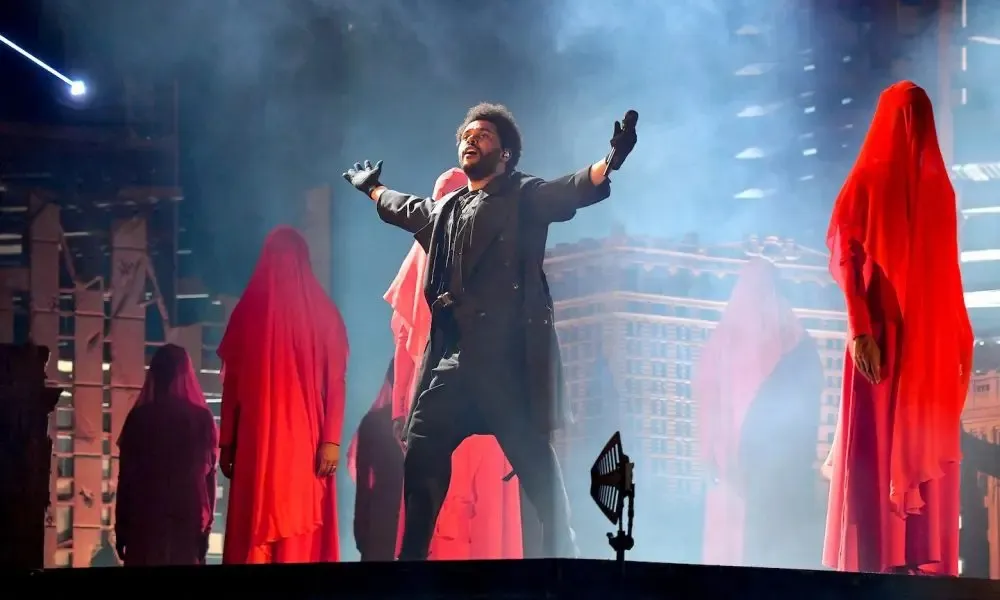

You Won’t Believe What The Weeknd’s Team Did to Cut Costs on His Most Ambitious Tour Yet
When The Weeknd announced his “After Hours til Dawn Tour”, fans were promised a spectacle unlike anything seen before. With its futuristic aesthetic, immersive visuals, and sprawling global dates, the tour was widely anticipated as one of the most ambitious pop spectacles of the decade. But behind the flashing lights, flame-throwing pyrotechnics, and massive LED stages lay a story few expected: a radical campaign by The Weeknd’s team to cut costs while maintaining a premium concert experience.

In a world where most major artists are inflating production budgets, The Weeknd’s tour took a different path — a calculated one, rooted in efficiency, innovation, and surprisingly frugal decisions that saved millions without fans noticing a single downgrade in quality.
The Pressure of Going Bigger While Spending Less
The challenge was clear: deliver a blockbuster tour experience that lived up to the surrealism and grandeur of the “After Hours” and “Dawn FM” albums, but without letting expenses spiral out of control. The Weeknd, born Abel Tesfaye, had just completed a string of successful ventures — a Super Bowl halftime show, a controversial yet talked-about HBO series, and the release of two critically acclaimed concept albums.
But as the tour’s production team began mapping out the cost structure, alarm bells rang. The scale of the proposed set — complete with post-apocalyptic skyline backdrops, drone lights, and synchronized stadium-wide effects — would rival the most expensive tours ever staged.
Yet Tesfaye and his team weren’t ready to compromise the vision. They instead turned to a multi-pronged strategy that would prioritize creative resourcefulness, technological innovation, and hard negotiation tactics with vendors and venues across continents.
Modular Set Design: The First Masterstroke
One of the most groundbreaking (yet invisible to fans) decisions made by The Weeknd’s crew was to engineer a modular set that could be disassembled and repurposed for every location. Unlike previous tours that shipped massive, permanent stage structures from city to city, this tour’s architecture was flexible, lightweight, and regionally adaptable.
Production designer Es Devlin, known for working with Beyoncé and Kanye West, helped design a skyline silhouette that could be projected rather than built, eliminating the need for costly 3D structures. Large components of the stage were made of light carbon materials, reducing freight weight by over 40%. This shift alone saved over $7 million in projected logistics costs.
Even more remarkably, the team employed local crews and regional subcontractors for much of the staging and rigging, cutting down on the need to fly out hundreds of workers or relocate massive caravans across the globe.
Visual Illusions Over Expensive Props
Rather than investing in heavy mechanical effects or elaborate physical props, The Weeknd’s creative directors leaned heavily on augmented reality and optical illusions. The show’s most talked-about moment — a massive red moon floating above the stage — was actually a projection mapped onto a translucent drone swarm, rather than a physical inflatable or lighting rig.
By using cutting-edge visuals and pre-rendered animations layered into the LED stage and overhead screens, the team gave the illusion of constant scene changes — burning cities, collapsing buildings, surreal dreamscapes — without actually shifting any physical sets. This digital-first approach allowed them to store and replicate effects seamlessly while eliminating the cost of rebuilding or transporting physical environments.
Rethinking Transportation: The Quiet Revolution
Behind the scenes, transportation logistics are often the most draining line items in a tour budget. Fuel, cargo flights, customs delays — they all add up. So The Weeknd’s team did something few A-list artists dare to do: they outsourced gear storage and transport to regional hubs. Rather than shipping all equipment globally, gear was duplicated and stored strategically across three continents.
This meant that while the North American leg used one set of lighting rigs and speakers, the European leg used a separate, identical system built and stored locally. While this might sound more expensive at first glance, it actually reduced freight time, customs risk, and carbon emissions, qualifying the tour for sustainability grants in several countries. In total, this transport revolution shaved nearly 18% off total logistical expenses.
Lean Staffing and AI-Powered Coordination
It wasn’t just the hardware that got optimized — the human component did too. Instead of taking an entourage of 300+ people, like some major tours, The Weeknd’s camp shrank its traveling crew to under 120 by leveraging AI scheduling platforms and remote production tools.
Backstage operations like lighting control, audio balancing, and even pyrotechnic timing were centralized to cloud-based systems, allowing technicians in LA or Toronto to monitor performances happening in Tokyo or Berlin. This meant that only the essential personnel — performers, front-of-house techs, security — had to travel, cutting down hotel and per diem costs substantially.
The tech also reduced human error. In past tours, human miscommunication could result in pyrotechnics misfiring or lighting being mistimed. Now, with a cloud-integrated control board, every aspect of the show was pre-programmed and synchronized with astonishing accuracy.
The Weeknd’s Personal Financial Discipline
Surprisingly, much of the cost-saving ethos was driven not by producers or managers, but by The Weeknd himself. Known for his enigmatic persona and luxury aesthetic, Tesfaye is fiscally conservative when it comes to business. Sources close to XO Records say he personally reviews budget proposals and pushed back against “excess for the sake of ego.”
For example, while many performers fly private jets between tour stops, The Weeknd often chartered smaller shared aircrafts or, in rare cases, even flew commercial first-class — decisions that saved six figures per week over the course of the tour.
He also declined branded hotel partnerships in favor of bulk booking discreet accommodations, avoiding the markup that typically comes with sponsoring deals. Even his wardrobe, while extravagant onstage, was coordinated to minimize cost-per-wear by rotating looks in clever ways most fans wouldn’t catch.
The Final Product: Luxury Without Waste
By the time the tour reached its final destination in South America, it had played to over 1.5 million fans, grossing an estimated $300 million — and yet came in 20% under budget compared to industry expectations for a tour of this size. Fans and critics alike praised the production as “immersive,” “cinematic,” and “flawlessly executed.”

Few knew they were witnessing a masterclass in financial engineering disguised as pop spectacle. The Weeknd’s team had achieved the impossible: maintaining the illusion of extravagance while executing one of the most cost-effective mega-tours in modern music history.
Redefining the Future of Touring
The implications of The Weeknd’s tour go far beyond his own brand. Industry insiders are already calling it a blueprint for future global tours. In an era where touring has become the primary income stream for many artists, and where fans are increasingly wary of high ticket prices, The Weeknd has proven that efficiency doesn’t have to compromise quality.
He also demonstrated that a conscious approach to sustainability, staffing, and digital innovation can produce shows that are not just impressive — but revolutionary.
So the next time you find yourself awestruck at a concert’s jaw-dropping visuals, remember this: sometimes, the most impressive thing happening isn’t onstage — it’s the quiet genius behind the curtain, making every dollar count.


















